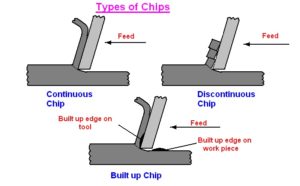TYPES OF CHIPS
In a metal cutting operation is carried out in machine shop. Chips are separated from the workpiece to impart the required size and shape to the workpiece. The type of chips edge formed is basically a function of the work material and cutting conditions. The chips that are formed during metal cutting operations can be classified into four types:
1. Discontinuous or segmental chips
2. Continuous chips
3. Continuous chips with built-up edge.
4. Non homogenous chips
The above three common types of chips are shown in Fig. shows continuous chips coming out during machining in machine shop. These types of chips are obtained while machining ductile material such as mild steel and copper. A continuous chip comes from the cutting edge of a cutting tool as a single one piece, and it will remain as one piece unless purposely broken for safety or for convenience in handling. Formation of very lengthy chip is hazardous to the machining process and the machine operators. It may wrap up on the cutting tool, work piece and interrupt in the cutting operation. Thus, it becomes necessary to deform or break long continuous chips into small pieces. It is done by using chip breakers. Chip breaker can be an integral part of the tool design or a separate device.
Fig. shows discontinuous chips coming out during machining in machine shop. In this type, the chip is produced in the form of small pieces. These types of chips are obtained while machining brittle material like cast iron, brass and bronze. Fairly good surface finish is obtained and tool life is increased with this type of chips.
Fig. shows continuous chip with built-up edge. During cutting operation, the temperature rises and as the hot chip passes over s the face of the tool, alloying and welding action may take place due to high pressure, which results in the formation of weak bonds in microstructure and weakened particles might pullout. Owing to high heat and pressure generated, these particles get welded to the cutting tip of the tool and form a false cutting edge. This is known as built-up edge.
Non homogenous chips are developed during machining highly hard alloys like titanium which suffers a marked decrease in yield strength with increase in temperature.
Source A Textbook of Basic Manufacturing Processes and Workshop Technology by Rajender Singh.













Post Comment
You must be logged in to post a comment.